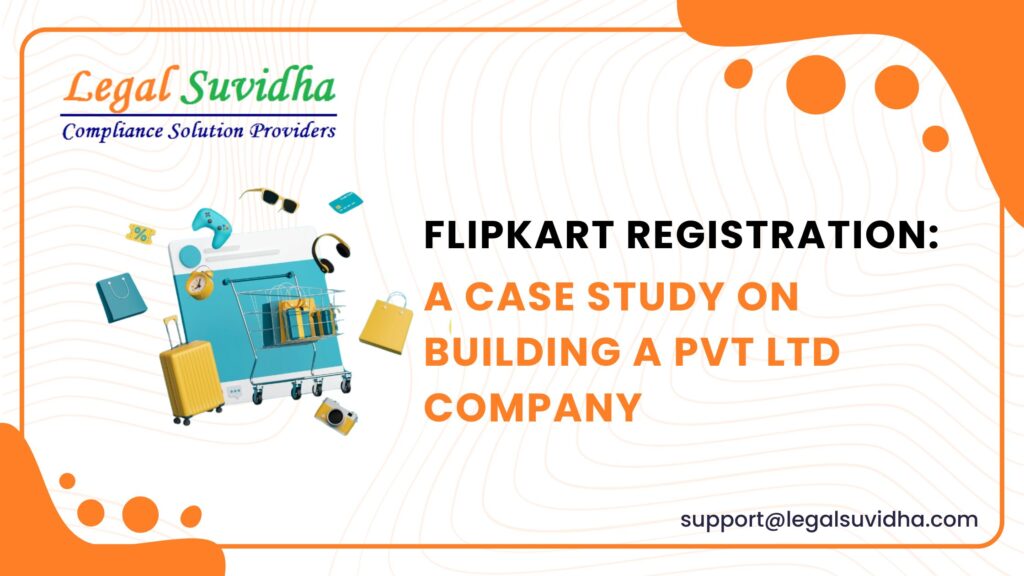Flipkart Registration: A Case Study on Building a Pvt Ltd Company
1. Introduction to Flipkart’s Success Story
Flipkart Private Limited was started by Sachin Bansal and Binny Bansal, who used to work at Amazon. They began as an online bookstore but quickly added more products, becoming India’s largest e-commerce platform. This success story shows Flipkart’s smart strategies and gives a plan for other business owners wanting to start a Private Limited company in India.
2. Understanding the Private Limited Company Structure
A Private Limited Company (Pvt Ltd) is a common business type in India known for its advantages, like limited liability, easy access to funding, and increased trust. Here’s why this structure is helpful:
- Limited Liability: Owners are only responsible for the company’s debts up to the amount they invested.
- Separate Legal Entity: The company is seen as a separate entity from its owners, which protects personal assets.
- Ease of Fundraising: Pvt Ltd companies can raise money by selling shares.
- Credibility: Registering as a Pvt Ltd company boosts a business’s trustworthiness.
3. Flipkart’s Private Limited Registration Process
Flipkart’s registration process had several steps:
Step 1: Early Preparation
- Choose a Company Name: The name had to be unique and not break any trademark rules. They chose “Flipkart.”
- Get Digital Signature Certificate (DSC): A DSC was needed for online registration.
- Apply for Director Identification Number (DIN): Both Sachin and Binny needed DINs to be directors.
Step 2: Company Name Approval
Flipkart sent a name approval request to the Registrar of Companies (ROC). They made sure “Flipkart” met legal standards and was available.
Step 3: Incorporation Documents
Flipkart submitted the following documents:
- Memorandum of Association (MoA): This outlined the company’s goals and activities.
- Articles of Association (AoA): This defined the company’s internal rules.
- Proof of Address: For the company’s registered office.
- ID and Address Proof: For the directors.
Step 4: Getting the Certificate of Incorporation
After submitting and verifying the documents, Flipkart received the Certificate of Incorporation from the ROC. This officially made Flipkart a registered Private Limited company.
4. Key Moments in Flipkart’s Growth
- 2007-2010: Flipkart started selling books online and introduced cash on delivery (COD), which helped gain customers’ trust.
- 2011-2014: Flipkart expanded into electronics, fashion, and lifestyle products and launched Flipkart Logistics, which improved e-commerce delivery in India.
- 2014-2016: Flipkart bought Myntra, Jabong, and other companies to grow its market and offerings.
- 2018: Walmart bought Flipkart for $16 billion, making it one of India’s biggest e-commerce deals.
5. Key Factors Behind Flipkart’s Success
- Adaptability: Flipkart adjusted to market changes and customer needs.
- Customer-Centric Approach: Focusing on customer satisfaction with easy returns and fast delivery built loyalty.
- Strategic Growth: Aggressive marketing, smart acquisitions, and expanding into new areas fueled success.
6. Lessons for Aspiring Entrepreneurs
- Strategic Planning: Flipkart’s focus on starting small and growing over time was key to its success.
- Customer Focus: Prioritizing customer needs and feedback drives growth and trust.
- Embracing Innovation: Constantly improving technology and operations is essential to staying competitive.
- Scaling Carefully: Smart growth and diversification help businesses grow sustainably.
7. Conclusion
Flipkart’s success shows the power of the Private Limited company structure and smart business practices. By following a clear registration process and focusing on innovation, customer satisfaction, and growth, entrepreneurs can build successful companies. Flipkart’s story is a helpful guide for anyone aiming to make a mark in e-commerce.
FAQs on Flipkart Registration and Private Limited Companies
Q1: What are the key benefits of registering a Pvt Ltd company?
A Private Limited company offers limited liability, separate legal status, easier fundraising, and increased trust.
Q2: How did Flipkart’s registration process help its success?
The registration process gave Flipkart a strong legal base, allowing the company to focus on growth and innovation.
Q3: What lessons can entrepreneurs learn from Flipkart’s story?
Entrepreneurs can learn the value of careful planning, customer focus, innovation, and smart growth from Flipkart.
Q4: How did Flipkart’s early innovations impact its growth?
Flipkart’s early innovations, like cash on delivery and efficient delivery services, helped build trust and spurred rapid growth.
Q5: What role did acquisitions play in Flipkart’s success?
Buying companies like Myntra helped Flipkart expand its products and strengthen its market position.


![Received an Income Tax Notice in India? Don’t Panic — Here’s Exactly What to Do [2025 Guide] 1 Income Tax Notice](https://legalsuvidha.com/wp-content/uploads/2025/12/Income-Tax-Notice.png)
![Cyber Crime FIR in India: How to File Complaint for Online Fraud, Banking Fraud & Digital Harassment [2025 Guide] 2 Cyber Crime Complaint](https://legalsuvidha.com/wp-content/uploads/2025/12/Cyber-Crime-Complaint.png)
![Trademark Infringement in India: How to File Legal Action & Protect Your Brand [2025 Guide] 3 Tradenark Infrigement](https://legalsuvidha.com/wp-content/uploads/2025/12/Tradenark-Infrigement.png)
![Property Title Verification in India: How to Check Clear Title in 7 Steps [Avoid Property Fraud – 2025 Guide] 4 Property Titles Verification](https://legalsuvidha.com/wp-content/uploads/2025/12/Property-Titles-Verification.png)



